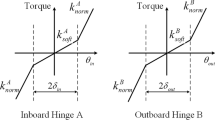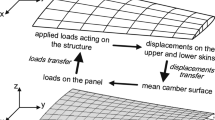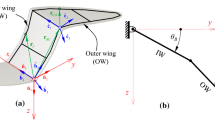Abstract
To investigate the aeroelastic stability of a folding wing effectively, a parametric aeroelastic analysis approach is proposed. First, the fixed interface component modal synthesis is used to derive the structural dynamic equation for a folding wing, in which the elastic connection is considered. The unsteady aerodynamic model is established by the doublet lattice method (DLM), and the aeroelastic model is achieved from integration of the DLM with the component modal analysis. The generalized aerodynamic influence coefficient matrix is established by modes kept and constraint modes of each component. The aeroelastic stability of a folding wing is investigated based on the Gram matrix in control theory. The effectiveness of the proposed method is verified via comparison with traditional flutter eigenvalue analysis for both extended and folded configurations. The proposed method identifies coupled modes and improves computational efficiency when compared to classical aeroelastic stability analysis methods, such as the p–k method.









Similar content being viewed by others

References
Wilson, J.R.: Morphing UAVs change the shape of warfare. Aerosp. Am. 42(2), 28–29 (2004)
Sofla, A.Y.N., Meguid, S.A., Tan, K.T., Yeo, W.K.: Shape morphing of aircraft wing: status and challenges. Mater. Des. 31, 1284–1292 (2010)
Lee, D.H., Weisshaar Terrence A.: Aeroelastic studies on a folding wing configuration. In: 46th AIAA/ASME/ASCE/AHS/ASC Structures, Strcutural Dynamics and Materials Conference, Austin, TX, 2005–1996 (2005)
Tang, D., Dowell, E.H.: Theoretical and experimental aeroelastic study for folding wing structures. J. Aircr. 45(4), 1136–1147 (2008)
Snyder, M.P., Sanders, B., Eastep, F.E., Frank, G.J.: Vibration and flutter characteristics of a folding wing. J. Aircr. 46(3), 791–799 (2009)
Wang, I., Gibbs, S.C., Dowell, E.H.: Aeroelastic model of multisegmented folding wings: theory and experiment. J. Aircr. 49(3), 911–921 (2012)
Zhao, Youhui, Hu, Haiyan: Paremeterized aeroelastic modeling and flutter analysis for a folding wing. J. Sound Vib. 331(2), 308–324 (2012)
Zhichun, Y., Yingsong, G., Wei, X.: New type of flutter solution based on matrix singularity. Acta Aeronaut. Astronaut. Sin. 30(6), 006 (2009). (in Chinese)
Yingsong, G., Zhichun, Y., Bin, L.: Flutter prediction based on multiplicative perturbation to dynamic pressure. Acta Aeronaut. Astronaut. Sin. 12, 012 (2009). (in Chinese)
Yang, Chao: Aircraft Aeroelastic Principles. Beihang University Press, Beijing (2011). (in Chinese)
Moore, B.C.: Principal component analysis in linear systems: controllability, observability, and model reduction. IEEE Trans. Autom. Control 26(1), 17–32 (1981)
Roh, Hyoun-Surk, Park, Yongjin: Actuator and exciter placement for flexible structures. J. Guid. Control Dyn. 20(5), 850–856 (1997)
Rowley, C.W.: Model reduction for fluids, using balanced proper orthogonal decomposition. Int. J. Bifurc. Chaos 15(3), 997–1013 (2005)
Bueno, D.D., Marqui, C.R., Goes, L.C.S., Goncalves, P.J.P.: The use of gramian matrices for aeroelastic stability analysis. Math. Probl. Eng. 2013(11), 289–325 (2013)
Rodden, W.P., Taylor, P.F., Mcintosh, S.C.: Further refinement of the subsonic doublet-lattice method. J. Airc. 35(5), 720–727 (1998)
Zhao, Yonghui: Aeroelatic Mechanics and Contol. Science Press, Beijing (2007). (in Chinese)
Abel, I.: An analytical technique for predicting the characteristics of a flexible wing equipped with an active flutter-suppression system and comparison with wind-tunnel data. NASA TP 1367 (1979)
Karpel, M.: Extensions to the minimum-state aeroelastic modeling method. Aiaa J. 29(11), 2007–2009 (2012)
Liu, Bao: Modern Control Theory.Mechanical Press, Beijing (2000). (in Chinese)
Author information
Authors and Affiliations
Corresponding author
Rights and permissions
About this article
Cite this article
Zhang, W., Lv, S. & Ni, Y. Parametric aeroelastic modeling based on component modal synthesis and stability analysis for horizontally folding wing with hinge joints. Nonlinear Dyn 92, 169–179 (2018). https://doi.org/10.1007/s11071-017-3956-5
Received:
Accepted:
Published:
Issue Date:
DOI: https://doi.org/10.1007/s11071-017-3956-5



